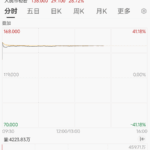While Apple Inc. reported substantial profits in the second quarter, the domestic consumer electronics industry has not experienced a full-scale boom.
Apple’s financial results for Q3 of fiscal year 2025 (Q2 2025) showed significant growth in both revenue and net profit, with particularly strong performance in Greater China, where revenue increased by 4.4% year-over-year, and iPhone shipments saw notable growth.
This growth has indeed benefited some of Apple’s supply chain partners. Key suppliers such as Luxshare Precision (002475.SZ), Foxconn Industrial Internet (601138.SH), Lingyi iTech (002600.SZ), and Avary Holding (002938.SZ) all reported solid earnings growth in the first half of the year.
However, the broader consumer electronics sector remains in a cyclical recovery phase, with many companies still reporting losses.
According to Wind data, 66 A-share listed companies in the consumer electronics sector have disclosed their preliminary or interim 2025 earnings reports. Of these, 39 reported profit growth or turned losses into gains, while 10 saw declining profits and 17 remained in the red. For comparison, in the same period last year, 44 of these 66 companies reported profit growth, indicating that the sector’s recovery still faces challenges.
Many companies noted that despite government subsidy policies, intensifying competition and declining product prices, coupled with slower-than-expected new product launches, have led to lower revenues and gross margins year-over-year.
Challenges: Rising Competition and Falling Prices
Since the second half of last year, there have been widespread expectations of a rebound in consumer electronics, with industry players increasingly optimistic about recovery. However, based on first-half performance, this recovery has been weaker than anticipated.
An analysis of interim earnings reports reveals common issues among underperforming companies, particularly intensified competition and declining product prices.
TPV Technology (000727.SZ), a display terminal manufacturer, expects a net loss of 450–490 million yuan in the first half, citing a global price war in the display industry, falling product prices, and stable panel costs, which squeezed gross margins. Additionally, increased market expansion efforts, overseas channel development, and exchange rate fluctuations contributed to the losses.
Similarly, Konka (000016.SZ) and Skyworth Digital (000810.SZ), both involved in display businesses, reported weak earnings. Konka expects a loss of 360–500 million yuan, while Skyworth Digital forecasts a 65.35%–76.35% drop in net profit to 43–63 million yuan.
Konka attributed its losses to fierce competition, delayed new product launches, and a product mix misaligned with subsidy policies, along with clearance of non-premium energy-efficient products. Skyworth Digital blamed declining smart device prices for reduced revenues and margins.
Other companies also highlighted competitive pressures weighing on prices.
For instance, chip distributor Infotmic (000670.SZ) expects a net loss of 26–36 million yuan due to falling product prices and low-margin new product lines. Precision component maker Anjie Technology (002635.SZ) forecasts a 55.96%–67.40% profit decline, citing lower order volumes and prices, as well as fixed cost pressures.
Some companies faced unique challenges. OFILM (002456.SZ) reported its first loss due to increased share-based compensation expenses, while Fenda Technology (002681.SZ) cited customer demands to share tariff-related costs and delayed orders as reasons for its profit decline.
Smartphone market data further underscores the sector’s struggles. According to Canalys, global smartphone shipments fell 1% YoY in Q2 2025, marking the first decline in six quarters. In China, January-May shipments dropped 2.8% to 118 million units, though production rose 0.5% to 563 million units in the first half.
A supply chain executive noted, “The smartphone market was sluggish in the first half, with no major breakthroughs. Order volumes were flat year-over-year, and while emerging businesses grew rapidly, their scale remains small.”
Growth Drivers: AI and Automotive Electronics
Among outperformers, Apple supply chain companies stood out. Foxconn Industrial Internet, Luxshare Precision, Lingyi iTech, and Avary Holding all posted profit growth, with Lingyi and Avary projecting increases of 31.57%–66.66% and 52.79%–60.62%, respectively.
Avary Holding credited cost controls, process improvements, and automation for higher profits, alongside better product mix and capacity utilization.
Despite their Apple ties,


